The Crotale ("Rattlesnake") 4 x 4 wheeled Air Defense Vehicle (ADV) system, known under the Hotchkiss's code P-4 R, was for decades the French short range SPAAML wheeled vehicle. It was originally designed to meet a South African requirement and its development cost was agreed shared 85% by South Africa, 15% by France. Locally called the "Cactus" it was eventually adopted by SANDF, through three vehicles anti-aircraft batteries. Meanwhile, Hotchkiss improved the carrier, and Matra (now Euromissile) the Crotale, created two radar carrier variants, and further work resulted in more international sales and widespread adoption by the French Army.
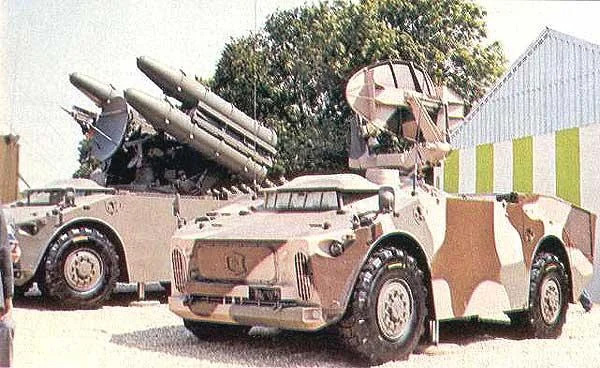
Cactus, exhibition vehicles, note the quircky camouflage
The Crotale is the missile, the P4R is the Hotchkiss carrier vehicle, fielded in two variant organically associated to each battery of three vehicle. There is an Acquisition and Control Unit (ACU) and the proper missile launching vehicle, the firing unit (FU). Both shares the same chassis, suspension and drive train as well as a similar armored hull. The ring mount is even identical but its adaptator changes to accomodate either he quad launcher or a radar.
This system was first planned in 1968, and development went on in 1969-70 at both Thomson and Hotchkiss, which met the requirements for the carrier vehicle. Delivery of the first prototypes commenced in 1971 and a small production followed in 1972-1973. The French air force, in charge of its bases defence, took interest interest in it whereas the Army ws interested by a completely different system, the AMX-30 based Roland. The missile system was later named after the "Crotale" (Rattlesnake) also present in the contested regions of Africa where the SANDF fought, albeit initially the system was locally known as the "cactus".
The whole system was designed to protect an armoured unit, engaging low-flying supersonic combat aircraft and the missile was powered by a solid fuel rocket motor. The carrier vehicle is called a "TELAR". Hotchkiss delivered a vehicle (later called by assimilation "Thomson-Hotchkiss P-4R") with a 4x4 (4 wheels driving, 2 wheels steering) chassis and simple, low armored hull.
P4R FU in NATO camouflage, early 1990s.
As a vehicle, Hotchkiss came out with a very singular set of solutions. The P4R indeed is relatively classic in its organization, with a rear engine, front transmission, driver's post and small command post for the operator. It has an unusual power transmission system similar to a diesel-electric locomotive shifter. The engine drives an alternator, which output is managed and redirected to DC motors driving the four wheels, through reduction gearing. That's a very unusual but clever solution for precise manoeuvering. The engine runs on gasoline on most vehicles but those operated by the United Arab Emirates (UAE) and Qatar. Due to local conditions, they are given a Baudouin 6F11 ST diesel. The Suspension are of the Messier type.
The P4R suspension is hydro-pneumatic and when deployed, they are raised on three hydraulic firing jacks, one behind each front wheel, a single at the rear. They hold the vehicle firmly in place when firing and are adjustable to 5 heights from 6-25.8 in (156-656 mm) depending on the terrain and conditions. The launcher vehicle has a four canister missiles, and small engagement radar, plus optical aiming system. The P4R armor is only proof against small arms fire and shrapnels. The crew of three comprises two operators seated behind the driver. The solution of electrical motors driving the wheels is related to its role of point defense, not to be part of a larger unit maneuver. Mobility is thus reduced, in speed (80 kph) and range (600 km). However it was shown able to climb a 60% slope, 30% side slope, 0.5 m step, gap a same width trench or ford up to 0.8m of water without preparation. Too heavy with no buoyancy reserve, the P4R is not amphibious. Its weight of 32,965 lb. (14,950 kg) is greater than the Radar vehicle (ACU) at 27,827 lb. (12,620 kg).
The P4R hull length is 20 ft 5 in (6.22 m) and 8 ft 9 in (2.72 m) in width, making it compact and low at just 6 ft 4 in (1.93 m) but 10 ft (3.05 m) in the ACU (radar) version and even taller at 11 ft 11 in (3.41 m) for the FU launch vehicle. Wheelbase is the same for all vehicles, at 11 ft 10 in (3.60 m) with a ground clearance whe travelling of 17.7 in (450 mm) up to 25.8 in (656 mm) when stationed on jacks. Top speed is on flat assimilated to 43.5 mph (70 km/h) for a 372 miles (600 km) range.
P4R ACU series 3000 deployed on an airbase.
The ACU carries an E-band pulse-Doppler surveillance and Acquisition radar and an Identification Friend or Foe (IFF) interrogator. The ACU also has a SN 1050 digital computer capable of tracking 30 targets, identifying the twelve most threatening ones, and passing that information through a digital data link to up to three missile launch vehicles. The P4R 1000/2000/3000 series vehicles are linked physically by cable that can extend up to 0.5 mi. (0.8 km). The 4000 and 5000 series vehicles have an LIVH radio link through a telescoping mast; ACU and launch vehicle can then be up to 1.9 mi. (3 km) apart.
P4R FU series 3000 deployed on an airbase.
The launch vehicle is fitted with a four-round launcher and a J-band monopulse tracking radar with a circular parabolic reflector. The radar can track one target and guide two missiles using a differential angle-error measurement technique that is said to be very accurate. A TV tracking system can be used if the radar is jammed. The system is ready to fire 6.5 seconds after target detection and can fire a missile every 2.5 seconds. When the missile is launched, it is gathered onto its initial flight path by a combination of Infrared (IR) tracking of the motor and radar tracking of the missile's transponders. Update commands are transmitted to the missile by the I-band command transmitter.
The battery comprised generally two or three P4R TELAR vehicles (FU) and a single acquisition radar vehicle (ACU). The unit is also accompanied by maintenance and support vehicles. The reload of all four missiles could be performed in two minutes.
The missile weights 185 lb. (84 kg), carrying a 33 lb. (15 kg) HE focalized fragmentation warhead. The missile had is a long, pointed cylinder with cruciform steerable foreplanes and "cropped delta" with mainplanes at its tail, 9 ft 7 3/4 in (2.94 m) long for 6.2 in (160 mm) in diameter and a wing span pf 1 ft 9 1/4 in (540 mm). The Crotale is powered by a SNPE Lens 10,692-lb. (4,850-kg) thrust solid-propellant motor enabling a 2.3 seconds primary combustion up to Mach 2.3, obtained from launch under 2.3 seconss. It is able to intercept targets flying as slow as 97 kts (112 mph; 180 km/h) up to 5.9 nm (6.8 mi.; 11 km) up to 487 kts (560 mph; 902 km/h) at 5.4 nm (6.2 mi.; 10 km).
It is able to intercept a target moving at 390 kts (449 mph; 723 km/h) and at 3.2 nm (3.7 mi.; 6 km) with a minimal engagement range of 1,640 ft (500 m) and altitude between 49 ft (15 m) and 16,404 ft (5,000 m). The ACU P4R carries a Thomson-CSF Mirador IV E-band pulse-Doppler radar for an optimal range of 10 nm (11.5 mi.; 18.5 km) and Thomson-CSF J-band monopulse radar capable of 8.6 nm (10 mi.; 16 km) plus a TV tracker with a 7.6 nm (8.7 mi.; 14 km) resolution. The missile itself has an IR proximity fuze and backup contact fuze.
P4R of the Barhaini forces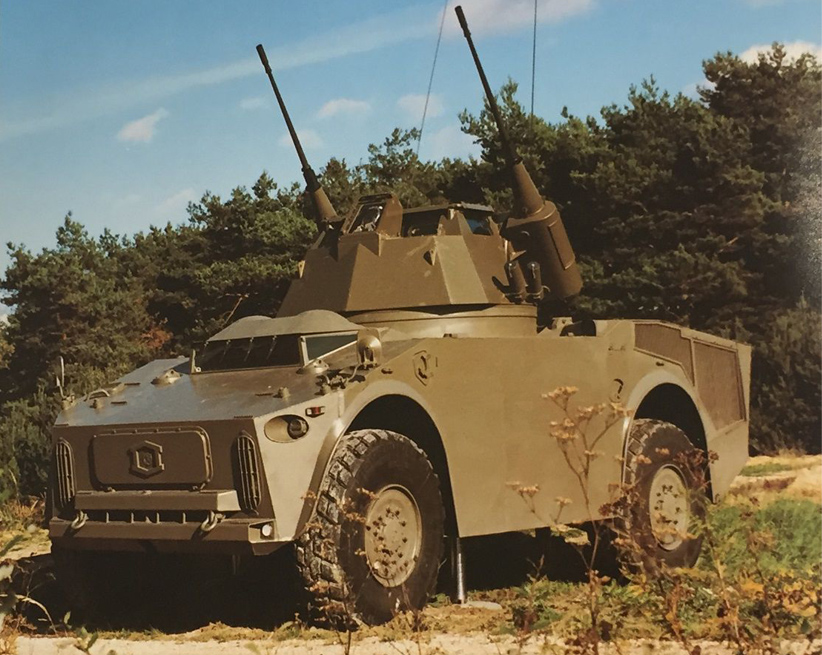
French proposed SPAAG conversion, GTS 20mm AA turret
The vehicle was first operational as planned with SANDF, qualified to full capability in 1971. But the vehicle was also exported to Libya in 1973. France adopted it in 1974, eleven other countries also purchased or obtained second-hand vehicles. In total 6,600 R440 missiles were produced by 1994. The potential thus for a potential production of 825 vehicle if each had a set of four reloads. Far less were manufactured however from 1969 to 1985 when production ceased (see below).
5 variants have been produced, the P4R 1000 in 1969, 2000 series by 1973, 3000 series by 1975, 4000 series in 1983 and 5000 in 1985 with iterative improvements.
The 4000 (1983) was the first fitted with a LIVH radio data link, replacing the old cable data link. This enables to more widely separates the launcher and Acquisition and Control Unit (CTU) beyond 3,000m. Pakistan received two batteries of this one. The Cable interconnections instead of radio datalink, 3 km apart unit and 10 km between ACU as well as improved electronic countermeasures.
The 5000 series could be fitted with two additional SATCP Mistral short-range SAMs on either side of the four-canister launcher, adding an extra close defence layer. There were variants based on completely new vehicle such as the Saudi Arabian Shahine I (60 Crotale with P4R vehicles under the 1981 Palmier program) but an upgrade contract was signed in 1990 under 2.2 billion Franc of the time to upgrade sensors and control systems at the Shahine II standard. The latter uses an AMX-30 chassis, tracked, and carried 6-round Crotale launchers.
A naval variant was also created for the Marine Nationale, delivered into a compact module, in order to be fitted anywhere on a ship. The Naval Crotale SAM system was copied by the Chinese. The Crotale New Generation missile introduced recently is an all-weather version, using co-located multi-sensor search as well as a new tracking system and launchers, and the Chinese created the FM-80 Shelter-mounted system, first seen in November.
Crotale NG (New Generation), 1990: Used the VT-1 missiles, smaller, more maneuverable, range 11 km, lethal radius 8 m. Mach 3.5 (1 160 m/s) and 8 missiles per launcher in small tube canisters. Radar and fire control system improved. A single vehicle performs acquisition and firing. Each can be linked to similar vehkcles in case, or early warning radars. The vehicle however uses now a 3-axle trailer.
Crotale Mk.3 (2008). The missile has been improved, with a range of 16 km, ceiling 9 km and new surveillance radar.
The Chinese HQ-7 is a Chinese reverse engineered copy after imports made in 1978-1979 for evaluation. The firt was tested in 1983, production commenced in the late 1980s and some authors dubbed it the "Sino-Crotale". Later a 6x6 chassis was also developed, the Chinese FM90.
The Shahab Tagheb is an Iranian short-range system revealed in 1999, developed with Chinese assistance and closely based on the HQ-7.
The Shahine was part of the "palm tree contract" for Saudi Arabia in 1980. In 1975 the P4R was delivered already for evaluation, and the Shahine II was based on AMX-30 tank chassis.

The related Saudi Shahine II, based onan AMX-30 chassis.
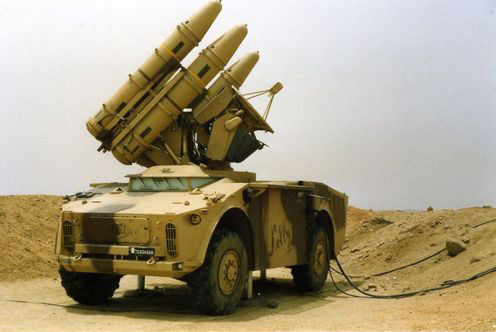
P4R Operation Daguet, 1991
The South African Cactus were used during the South African border war. Operation El Durado Canyon (April 14-15th 1986) saw one unit able to shoot down a General Dynamics F-111 Aardvark. France had some units deployed to Chad and by 7 September, 1987 they shoot down a Libyan Tu-22 when approaching from Abeche base. No hit as recorded, but the attacker withdrawn. Iraq possessed a number of batteries and they were used against Iran, while the remaining saw action in the 1991 Gulf War, opposite France which also deployed this system to protect its rear bases in the same war. Saudi Arabia deployed thus around Kuwait's capitol after the country's liberation in February 1991.
en.missilery.info
defense-arab.com
paluba.info
artillerie.asso.fr
pdf.defence.pk
militarytoday.com
valka.cz/
fr.wikipedia.org/
babriet.tripod.com
Design of the weapons system

Cactus, exhibition vehicles, note the quircky camouflage
The Crotale is the missile, the P4R is the Hotchkiss carrier vehicle, fielded in two variant organically associated to each battery of three vehicle. There is an Acquisition and Control Unit (ACU) and the proper missile launching vehicle, the firing unit (FU). Both shares the same chassis, suspension and drive train as well as a similar armored hull. The ring mount is even identical but its adaptator changes to accomodate either he quad launcher or a radar.
Development
The Crotale P4R came at the time of the Apartheid policy, with only France and Israel willing to negociate armament contracts with the South Africans. The latter, engaged in a bitter war with the Cubans in neighbouring countries, were in need of a mobile air defense system. They sent a delegation to several manufacturers and settled on Thomson-Houston (Later Thomson-CSF, now Thales) for a vehicle of point-defence, but wheeled and mobile, tailored for their needs. It was understood that the development cost would be assumed in majority by South Africa (France had no such requirement at the time), the remainder by France as a guarantee for possible exports.This system was first planned in 1968, and development went on in 1969-70 at both Thomson and Hotchkiss, which met the requirements for the carrier vehicle. Delivery of the first prototypes commenced in 1971 and a small production followed in 1972-1973. The French air force, in charge of its bases defence, took interest interest in it whereas the Army ws interested by a completely different system, the AMX-30 based Roland. The missile system was later named after the "Crotale" (Rattlesnake) also present in the contested regions of Africa where the SANDF fought, albeit initially the system was locally known as the "cactus".
The whole system was designed to protect an armoured unit, engaging low-flying supersonic combat aircraft and the missile was powered by a solid fuel rocket motor. The carrier vehicle is called a "TELAR". Hotchkiss delivered a vehicle (later called by assimilation "Thomson-Hotchkiss P-4R") with a 4x4 (4 wheels driving, 2 wheels steering) chassis and simple, low armored hull.
The Hotchkiss P4R

P4R FU in NATO camouflage, early 1990s.
As a vehicle, Hotchkiss came out with a very singular set of solutions. The P4R indeed is relatively classic in its organization, with a rear engine, front transmission, driver's post and small command post for the operator. It has an unusual power transmission system similar to a diesel-electric locomotive shifter. The engine drives an alternator, which output is managed and redirected to DC motors driving the four wheels, through reduction gearing. That's a very unusual but clever solution for precise manoeuvering. The engine runs on gasoline on most vehicles but those operated by the United Arab Emirates (UAE) and Qatar. Due to local conditions, they are given a Baudouin 6F11 ST diesel. The Suspension are of the Messier type.
The P4R suspension is hydro-pneumatic and when deployed, they are raised on three hydraulic firing jacks, one behind each front wheel, a single at the rear. They hold the vehicle firmly in place when firing and are adjustable to 5 heights from 6-25.8 in (156-656 mm) depending on the terrain and conditions. The launcher vehicle has a four canister missiles, and small engagement radar, plus optical aiming system. The P4R armor is only proof against small arms fire and shrapnels. The crew of three comprises two operators seated behind the driver. The solution of electrical motors driving the wheels is related to its role of point defense, not to be part of a larger unit maneuver. Mobility is thus reduced, in speed (80 kph) and range (600 km). However it was shown able to climb a 60% slope, 30% side slope, 0.5 m step, gap a same width trench or ford up to 0.8m of water without preparation. Too heavy with no buoyancy reserve, the P4R is not amphibious. Its weight of 32,965 lb. (14,950 kg) is greater than the Radar vehicle (ACU) at 27,827 lb. (12,620 kg).
The P4R hull length is 20 ft 5 in (6.22 m) and 8 ft 9 in (2.72 m) in width, making it compact and low at just 6 ft 4 in (1.93 m) but 10 ft (3.05 m) in the ACU (radar) version and even taller at 11 ft 11 in (3.41 m) for the FU launch vehicle. Wheelbase is the same for all vehicles, at 11 ft 10 in (3.60 m) with a ground clearance whe travelling of 17.7 in (450 mm) up to 25.8 in (656 mm) when stationed on jacks. Top speed is on flat assimilated to 43.5 mph (70 km/h) for a 372 miles (600 km) range.
P4R ACU (radar unit)

P4R ACU series 3000 deployed on an airbase.
The ACU carries an E-band pulse-Doppler surveillance and Acquisition radar and an Identification Friend or Foe (IFF) interrogator. The ACU also has a SN 1050 digital computer capable of tracking 30 targets, identifying the twelve most threatening ones, and passing that information through a digital data link to up to three missile launch vehicles. The P4R 1000/2000/3000 series vehicles are linked physically by cable that can extend up to 0.5 mi. (0.8 km). The 4000 and 5000 series vehicles have an LIVH radio link through a telescoping mast; ACU and launch vehicle can then be up to 1.9 mi. (3 km) apart.
P4R FU (Fire unit)

P4R FU series 3000 deployed on an airbase.
The launch vehicle is fitted with a four-round launcher and a J-band monopulse tracking radar with a circular parabolic reflector. The radar can track one target and guide two missiles using a differential angle-error measurement technique that is said to be very accurate. A TV tracking system can be used if the radar is jammed. The system is ready to fire 6.5 seconds after target detection and can fire a missile every 2.5 seconds. When the missile is launched, it is gathered onto its initial flight path by a combination of Infrared (IR) tracking of the motor and radar tracking of the missile's transponders. Update commands are transmitted to the missile by the I-band command transmitter.
The battery comprised generally two or three P4R TELAR vehicles (FU) and a single acquisition radar vehicle (ACU). The unit is also accompanied by maintenance and support vehicles. The reload of all four missiles could be performed in two minutes.
The Crotale Missile
The Prime contractor is the one for the missile and associated radars, Thomson-CSF, located at Bagneux, France while the missile itself was manufactured by Matra located in Velizy, France. Hotchkiss plant was located at Viviez near Rodez. The Crotale missile is installed in a cylindrical, serrated canister, at the factory. The Crotale missile carries a conventional High Explosive (HE) warhead and its estimated destruction radius is circa 26 ft (8 m). Hit probability was noted as being at least 80%. No spare missiles could be store in the P4R so reloads comes from following trucks, transferred by crane with two minutes of handing for a full reload by the well-trained P4R crew (three).The missile weights 185 lb. (84 kg), carrying a 33 lb. (15 kg) HE focalized fragmentation warhead. The missile had is a long, pointed cylinder with cruciform steerable foreplanes and "cropped delta" with mainplanes at its tail, 9 ft 7 3/4 in (2.94 m) long for 6.2 in (160 mm) in diameter and a wing span pf 1 ft 9 1/4 in (540 mm). The Crotale is powered by a SNPE Lens 10,692-lb. (4,850-kg) thrust solid-propellant motor enabling a 2.3 seconds primary combustion up to Mach 2.3, obtained from launch under 2.3 seconss. It is able to intercept targets flying as slow as 97 kts (112 mph; 180 km/h) up to 5.9 nm (6.8 mi.; 11 km) up to 487 kts (560 mph; 902 km/h) at 5.4 nm (6.2 mi.; 10 km).
It is able to intercept a target moving at 390 kts (449 mph; 723 km/h) and at 3.2 nm (3.7 mi.; 6 km) with a minimal engagement range of 1,640 ft (500 m) and altitude between 49 ft (15 m) and 16,404 ft (5,000 m). The ACU P4R carries a Thomson-CSF Mirador IV E-band pulse-Doppler radar for an optimal range of 10 nm (11.5 mi.; 18.5 km) and Thomson-CSF J-band monopulse radar capable of 8.6 nm (10 mi.; 16 km) plus a TV tracker with a 7.6 nm (8.7 mi.; 14 km) resolution. The missile itself has an IR proximity fuze and backup contact fuze.
Career and Operators

P4R of the Barhaini forces
Variants

French proposed SPAAG conversion, GTS 20mm AA turret
The vehicle was first operational as planned with SANDF, qualified to full capability in 1971. But the vehicle was also exported to Libya in 1973. France adopted it in 1974, eleven other countries also purchased or obtained second-hand vehicles. In total 6,600 R440 missiles were produced by 1994. The potential thus for a potential production of 825 vehicle if each had a set of four reloads. Far less were manufactured however from 1969 to 1985 when production ceased (see below).
5 variants have been produced, the P4R 1000 in 1969, 2000 series by 1973, 3000 series by 1975, 4000 series in 1983 and 5000 in 1985 with iterative improvements.
The 4000 (1983) was the first fitted with a LIVH radio data link, replacing the old cable data link. This enables to more widely separates the launcher and Acquisition and Control Unit (CTU) beyond 3,000m. Pakistan received two batteries of this one. The Cable interconnections instead of radio datalink, 3 km apart unit and 10 km between ACU as well as improved electronic countermeasures.
The 5000 series could be fitted with two additional SATCP Mistral short-range SAMs on either side of the four-canister launcher, adding an extra close defence layer. There were variants based on completely new vehicle such as the Saudi Arabian Shahine I (60 Crotale with P4R vehicles under the 1981 Palmier program) but an upgrade contract was signed in 1990 under 2.2 billion Franc of the time to upgrade sensors and control systems at the Shahine II standard. The latter uses an AMX-30 chassis, tracked, and carried 6-round Crotale launchers.
A naval variant was also created for the Marine Nationale, delivered into a compact module, in order to be fitted anywhere on a ship. The Naval Crotale SAM system was copied by the Chinese. The Crotale New Generation missile introduced recently is an all-weather version, using co-located multi-sensor search as well as a new tracking system and launchers, and the Chinese created the FM-80 Shelter-mounted system, first seen in November.
Crotale NG (New Generation), 1990: Used the VT-1 missiles, smaller, more maneuverable, range 11 km, lethal radius 8 m. Mach 3.5 (1 160 m/s) and 8 missiles per launcher in small tube canisters. Radar and fire control system improved. A single vehicle performs acquisition and firing. Each can be linked to similar vehkcles in case, or early warning radars. The vehicle however uses now a 3-axle trailer.
Crotale Mk.3 (2008). The missile has been improved, with a range of 16 km, ceiling 9 km and new surveillance radar.
The Chinese HQ-7 is a Chinese reverse engineered copy after imports made in 1978-1979 for evaluation. The firt was tested in 1983, production commenced in the late 1980s and some authors dubbed it the "Sino-Crotale". Later a 6x6 chassis was also developed, the Chinese FM90.
The Shahab Tagheb is an Iranian short-range system revealed in 1999, developed with Chinese assistance and closely based on the HQ-7.
The Shahine was part of the "palm tree contract" for Saudi Arabia in 1980. In 1975 the P4R was delivered already for evaluation, and the Shahine II was based on AMX-30 tank chassis.

The related Saudi Shahine II, based onan AMX-30 chassis.
Combat records

P4R Operation Daguet, 1991
The South African Cactus were used during the South African border war. Operation El Durado Canyon (April 14-15th 1986) saw one unit able to shoot down a General Dynamics F-111 Aardvark. France had some units deployed to Chad and by 7 September, 1987 they shoot down a Libyan Tu-22 when approaching from Abeche base. No hit as recorded, but the attacker withdrawn. Iraq possessed a number of batteries and they were used against Iran, while the remaining saw action in the 1991 Gulf War, opposite France which also deployed this system to protect its rear bases in the same war. Saudi Arabia deployed thus around Kuwait's capitol after the country's liberation in February 1991.
Links
ausairpower.neten.missilery.info
defense-arab.com
paluba.info
artillerie.asso.fr
pdf.defence.pk
militarytoday.com
valka.cz/
fr.wikipedia.org/
babriet.tripod.com
Panhard P4R specifications | |
| Dimensions (l-w-h): | 6.22 x 2.65 x 2.04 m |
| Total weight, battle ready: | 14.8 t |
| Crew : | 3: 1 Driver, 2 Operators |
| Propulsion: | Hotchkiss gasoline or Baudouin 6F11 ST 204-bhp diesel |
| Suspensions: | Hydropneumatic, see notes |
| Top Speed | 80 km/h |
| Range (flat) | 600 km/h |
| Armament | 4x Crotale SAM |
| Armour | 3-5 mm |
| Total Production | c1,200 |
Gallery
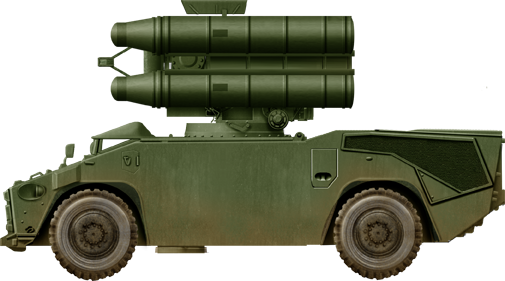
P4R Crotale of the 3000 series
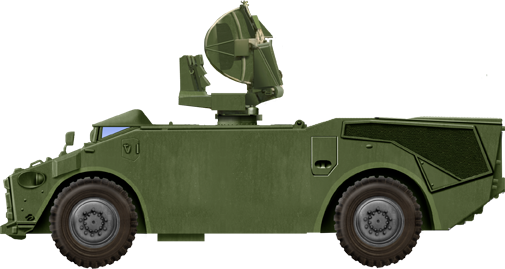
P4R Radar Type 1 (3000 series)

P4R ACU type 2 (5000 series)
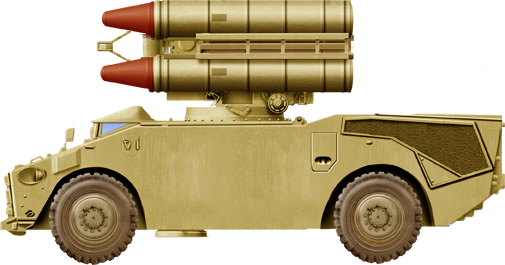
P4R tested by Egypt
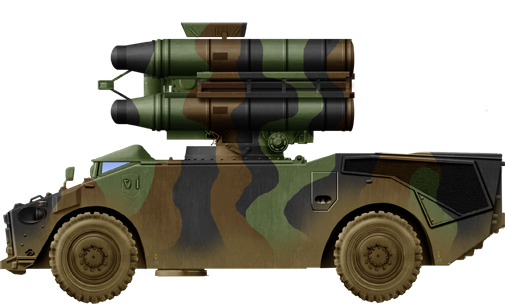
French P4R in the 1990s NATO livery
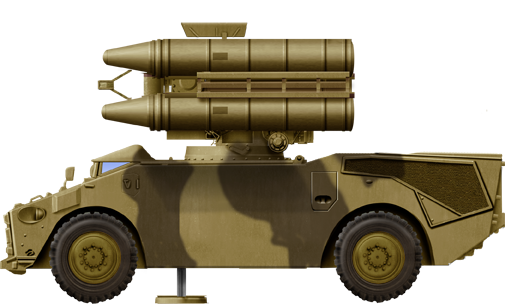
French P4R as part of Daguet Division, Gulf War 1991
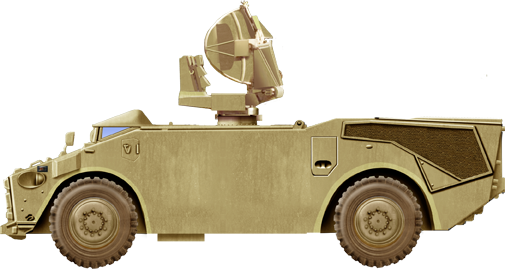
Barhain vehicle in the 2000s

South African Cactus

French vehicle camouflaged, 1990s.

Pakistani vehicles
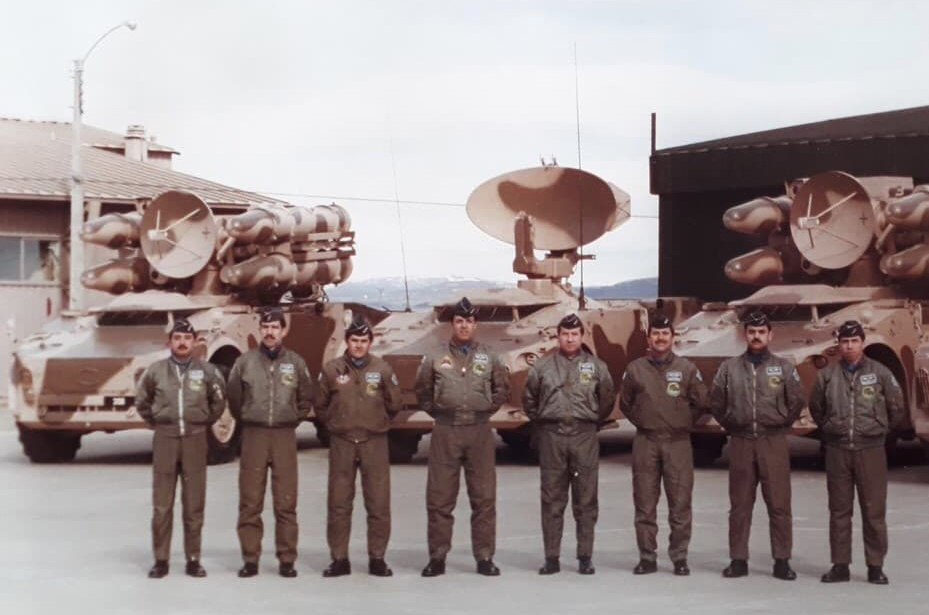
Chilean P4R
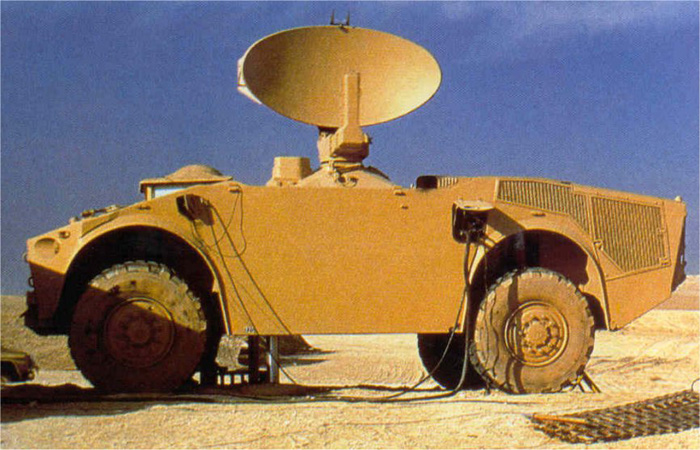
Unknown country's vehicle, desert tan livery, ACU
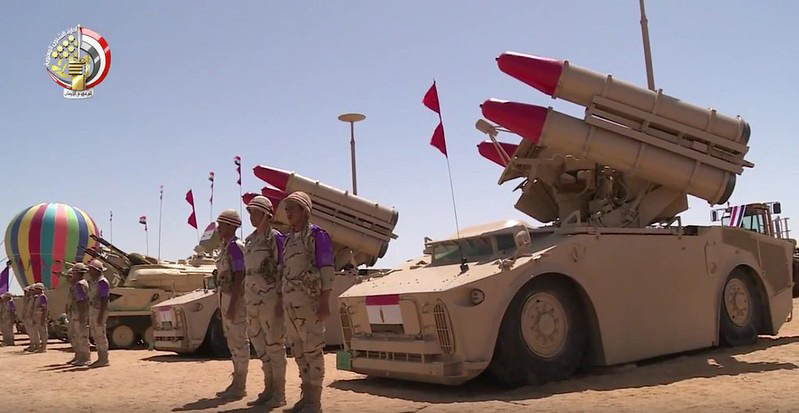
Unknown vehicle, perhaps egyptian based on flag

Barhaini vehicles in parade

Cold War Tanks


































Cold war tanks posters

Cold War Main Battle Tanks

Cold War Soviet Army
Museums, Movies, Books & Games
The Tanks and Armor in pop culture
Tanks and armored vehicles in general are only really grasped when seen first person: The mass, the scale, it's all there. Explore also the way tanks were covered in the movie industry, in books and in video games.Movies:
Best tanks movie on warhistoryonline.com
On imdb.com
On bestsimilar.com/
miltours.com
liveabout.com/
watchmojo.com
Video Games:
pcgamesn.com
historyhit.com
levvvel.com
vg247.com/best-tank-games
mmobomb.com/
alienwarearena.com

